ISSN ONLINE(2319-8753)PRINT(2347-6710)
ISSN ONLINE(2319-8753)PRINT(2347-6710)
B. Rajini1, A.V. Narasimha Rao2
|
| Related article at Pubmed, Scholar Google |
Visit for more related articles at International Journal of Innovative Research in Science, Engineering and Technology
The objective of this project is to study the effect of class fly ash (FA) and ground granulated blast furnace slag (GGBS) on the mechanical properties of geopolymer concrete (GPC) at different replacement levels (FA0-GGBS100, FA25-GGBS75, FA50-GGBS50; FA75-GGBS25, FA100, GGBS0). Sodium silicate (Na2SiO3) and sodium hydroxide (NaOH) solution have been used as alkaline activators. In the present investigation, it is proposed to study the mechanical properties viz. compressive strength, split tensile strength of low calcium fly ash and GGBS based geopolymer concrete. These properties have been determined at different curing periods like 7, 28, 56 and 90 days and at ambient room temperature.
Keywords |
| Geopolymer concrete, sodium silicate, sodium hydroxide, fly ash, granulated blast furnace slag, compressive strength, split tensile strength. |
INTRODUCTION |
| The production of Portland cement consumes considerable energy and at the same time contributes a large volume of CO2 to the atmosphere. The climate change due to global warming has become a major concern. The global warming is caused by the emission of greenhouse gases, such as carbon dioxide (CO2), to the atmosphere by human activities. The cement industry is held responsible for some of the CO2 emissions, because the production of one ton of Portland cement emits approximately one ton of CO2 into the atmosphere [1]. However, Portland cement is still the main binder in concrete construction prompting a search for more environmentally friendly materials. Several efforts are in progress to supplement the use of Portland cement in concrete in order to address the global warming issues. These include the utilization of supplementary cementing materials such as fly ash, silica fume, granulated blast furnace slag, rice-husk ash and metakaolin, and the development of alternative binders to Portland cement. One possible alternative is the use of alkali-activated binder using industrial by-products containing silicate materials. In 1978, Davidovits proposed that binders could be produced by a polymeric reaction of alkaline liquids with the silicon and the aluminium in source materials of geological origin or by-product materials such as fly ash, GGBS and rice husk ash. He termed these binders as geopolymer [1]. The most common industrial by-products used as binder materials are fly ash (FA) and ground granulated blast furnace slag (GGBS) [2-4]. |
| In 2001, when this research began, several publications were available describing geopolymer pastes and geopolymer coating materials [5-7]. However, very little was available in the published literature regarding the use of geopolymer technology to make low-calcium (ASTM Class F) fly ash and GGBS based geopolymer concrete. The research reported in this paper was dedicated to investigate the process of making fly ash and GGBS based geopolymer concrete and the short-term engineering properties of the hardened concrete. The bjective of this project is to develop and study the compressive strength and split tensile strength of fly ash and GGBS based GPC mixes with different proportions at various curing period at ambient room temperature curing. |
EXPERIMENTAL INVESTIGATION |
| 1. Materials |
| Although geopolymer concrete can be made using various source materials, the present study used class F fly ash and GGBS. Also, as in the case of OPC, the aggregates occupied 75-80 % of the total mass of concrete. The following sections discuss constituent materials used for manufacturing GPC. Chemical and physical properties of the constituent materials are presented in this section. |
| Following materials are generally used to produce GPCs:- |
| (i) Fly Ash (FA) |
| (ii) Ground Granulated Blast Furnace Slag (GGBS) |
| (iii) Fine aggregate and |
| (iv) Coarse aggregate |
| (v) Alkaline liquid |
| a. Fly Ash |
| Fly ash (FA) is a by-product of the combustion of pulverized coal in thermal power plants. It is a fine grained, powdery and glassy particulate material that is collected from the exhaust gases by electrostatic precipitators or bag filters. When pulverised coal is burnt to generate heat, the residue contains 80 per cent fly ash and 20 per cent bottom ash. The size of particles is largely dependent on the type of dust collection equipment. Diameter of fly ash particles ranges from less than 1 μm–150 μm. It is generally finer than Portland cement. Their surface area is typically 300 to 500 m2/kg, although some fly ashes can have surface areas as low as 200 m2/kg and as high as 700 m2/kg. However, the effect of increase in specific surface area beyond 600 m2/kg is reported to be insignificant. |
| b. Ground Granulated Blast Furnace Slag |
| Ground granulated blast furnace slag (GGBS) is a by-product from the blast-furnaces used to make iron. These operate at a temperature of about 1,500 degrees centigrade and are fed with a carefully controlled mixture of iron-ore, coke and limestone. The iron ore is reduced to iron and the remaining materials form a slag that floats on top of the iron. This slag is periodically tapped off as a molten liquid and if it is to be used for the manufacture of GGBS it has to be rapidly quenched in large volumes of water. The quenching, optimises the cementitious properties and produces granules similar to a coarse sand. This „granulated slagâÃâ¬ÃŸ is then dried and ground to a fine powder. GGBS is one of the „greenestâÃâ¬ÃŸ of construction materials as well as the environmental benefit of utilizing a by-product, GGBS replaces something that is produced by a highly energy-intensive process. By comparison with Portland cement, manufacture of GGBS requires less than a fifth the energy and produces less than a fifteenth of the carbon dioxide emissions. |
| c. Fine aggregate |
| Natural river sand was used as fine aggregate. The bulk specific gravity in oven dry condition and water absorption of the sand as per IS 2386 (Part III, 1963) [8] were 2.62 and 1% respectively. The gradation of the sand was determined by sieve analysis as per IS 383 (1970) [9] and presented in the Table 1. The grading curve of the fine aggregate as per IS 383 (1970) [9] is shown in Fig.1. Fineness modulus of sand was found to be 2.69. |
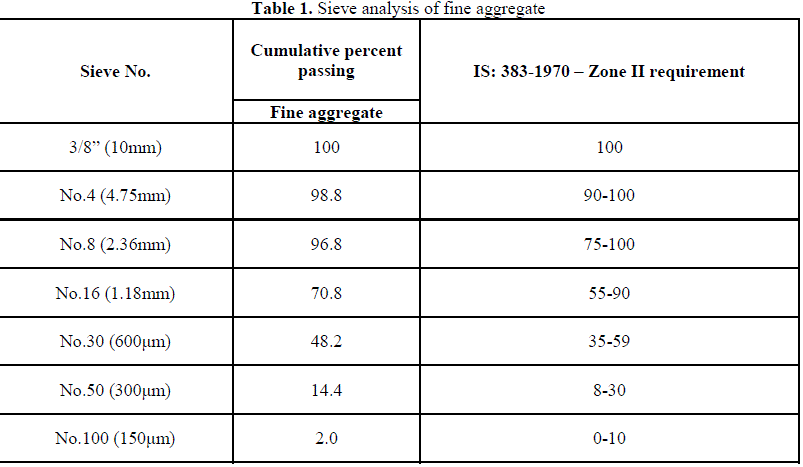 |
 |
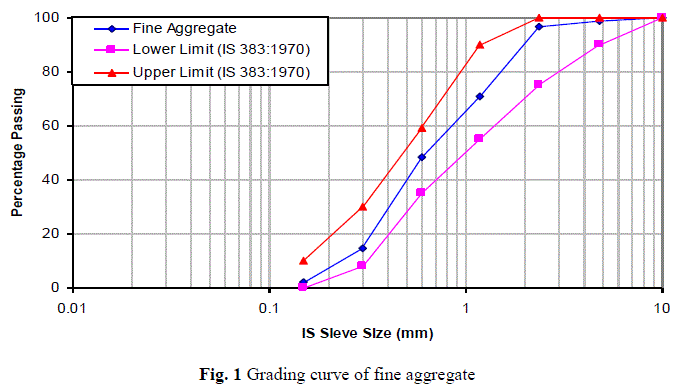 |
| d. Coarse aggregate |
| Crushed granite stones of size 20 mm and 10 mm were used as coarse aggregate. The bulk specific gravity in oven dry condition and water absorption of the coarse aggregate 20 mm and 10mm as per IS 2386 (Part III, 1963) [8] were 2.58 and 0.30% respectively. The gradation of the coarse aggregate of size 20mm and 10mm was determined by sieve analysis as per IS 383 (1970) [9] and presented in the Tables 2 and 3 respectively. The grading curves of the coarse aggregates as per IS 383 (1970) [9] are shown in Figs. 2 and 3 respectively. |
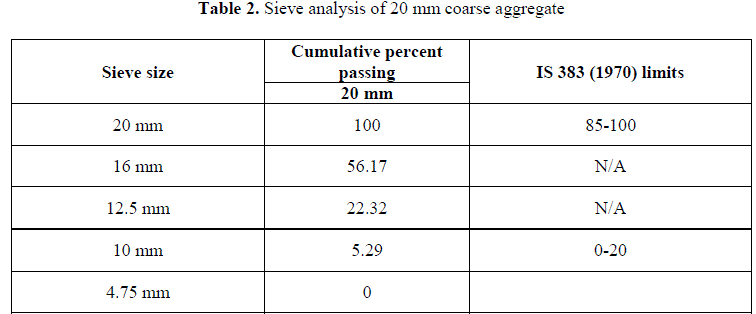 |
 |
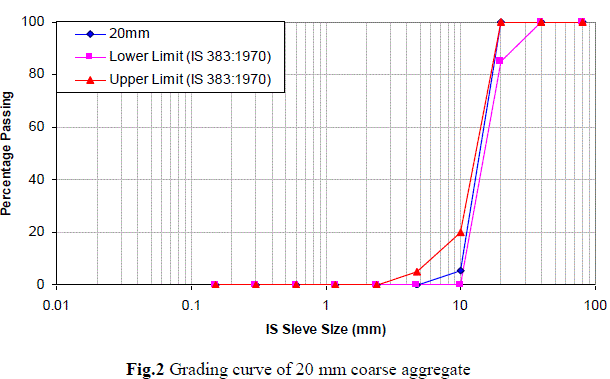 |
| e.Alkaline liquid |
| The alkaline liquid used was a combination of sodium silicate solution and sodium hydroxide solution. The sodium silicate solution (Na2O= 13.7%, SiO2=29.4%, and water=55.9% by mass) was purchased from a local supplier. The sodium hydroxide (NaOH) in flakes or pellets from with 97%-98% purity was also purchased from a local supplier. The sodium hydroxide (NaOH) solution was prepared by dissolving either the flakes or the pellets in water. The mass of NaOH solids in a solution varied depending on the concentration of the solution expressed in terms of molar, M. For instance, NaOH solution with a concentration of 10M consisted of 10x40 = 400 grams of NaOH solids (in flake or pellet form) per litre of the solution, where 40 is the molecular weight of NaOH. |
| Test conducted on fly ash |
| The following test is conducted on fly ash |
| (i) Specific gravity |
| Result:- |
| The specific gravity of fly ash=2.133 |
| Test conducted on ground granulated blast furnace slag (GGBS) |
| The following test is conducted on GGBS |
| (i) Specific gravity |
| Result:- |
| The specific gravity of GGBS=2.92 |
| Tests conducted on fine aggregate |
| The following tests are conducted on fine aggregate |
| (i) Specific gravity |
| (ii) Water absorption |
| (iii) Finesse modulus |
| Result:- |
| The specific gravity of fine aggregate=2.415 |
| Water absorption for fine aggregate=1% |
| Finesse modulus of fine aggregate=2.47 |
| Tests conducted on coarse aggregate |
| The following tests are conducted on coarse aggregate of size 10mm and 20mm |
| (i) Specific gravity |
| (ii) Water absorption |
| (iii) Finesse modulus |
| Result:- |
| The specific gravity of coarse aggregate =2.16 |
| Water absorption for 10mm coarse aggregate=0.3% |
| Water absorption for 20mm coarse aggregate=0.3% |
| Finesse modulus for 10mm coarse aggregate=5.89 |
| Finesse modulus for 20mm coarse aggregate=6.95 |
| 2. Mix design |
| Hardjito and Rangan (2005) [10] have noted that unlike conventional cement concretes GPCs are a new class of construction materials and therefore no standard mix design approaches are yet available for GPC. GPC involves more constituents in its binder (viz., FA, GGBS, sodium silicate, sodium hydroxide and water), whose interactions and final structure and chemical composition are under intense research. |
| Assume that normal-density aggregates in SSD condition are to be used and the unit-weight of concrete is 2400 kg/m3. Take the mass of combined aggregates as 77% of the mass of concrete, i.e. 0.77x2400=1848 kg/m3. The combined aggregates may be selected to match the standard grading curves used in the design of Portland cement concrete mixtures. For instance, the coarse aggregates (70%) may comprise 776 kg/m3 (60%) of 20 mm aggregates, 517 kg/m3 (40%) of 10 mm aggregates, and 554 kg/m3 (30%) of fine aggregate to meet the requirements of standard grading curves. After considering the water absorption values of coarse and fine aggregates, the adjusted values of coarse and fine aggregates are 774 kg/m3 of 20 mm aggregates, 516 kg/m3 of 10 mm aggregates and 549 kg/m3 (30%) of fine aggregate. |
| The mass of geopolymer binders (fly ash and GGBS) and the alkaline liquid = 2400 – 1848 = 552 kg/m3. Take the alkaline liquid-to-fly ash ratio by mass as 0.35; the mass of fly ash = 552/ (1+0.35) = 409 kg/m3 and the mass of alkaline liquid = 552 – 409 = 143 kg/m3. Take the ratio of sodium silicate solution-to-sodium hydroxide solution by mass as 2.5; the mass of sodium hydroxide solution = 144/ (1+2.5) = 41 kg/m3; the mass of sodium silicate solution = 143 – 41 =102 kg/m3. The sodium hydroxide solids (NaOH) is mixed with water to make a solution with a concentration of 10 Molar. This solution comprises 40% of NaOH solids and 60% water, by mass. For the trial mixture, water-to-geopolymer solids ratio by mass is calculated as follows: In sodium silicate solution, water = 0.559x102 = 57 kg, and solids = 102 – 57 = 45 kg. In sodium hydroxide solution, solids = 0.40x41 = 16 kg, and water = 41 – 16 = 25 kg. Therefore, total mass of water = 57+25 = 82 kg, and the mass of geopolymer solids = 409 (i.e. mass of fly ash and GGBS) + 45 + 16 = 470 kg. Hence, the water-to-geopolymer solids ratio by mass = 82/470 = 0.17. Extra water of 55 litres is calculated on trial basis to get adequate workability. M 45 grade of conventional concrete (CC) has been designed as per IS 10262:2009 [11] and IS 456:2000 [12] for comparative study. The mix proportions of CC and GPC mixes are presented in Table 4. |
 |
RESULTS AND DISCUSSION |
| 1. Mechanical properties of CC and GPC |
| a. Compressive strength |
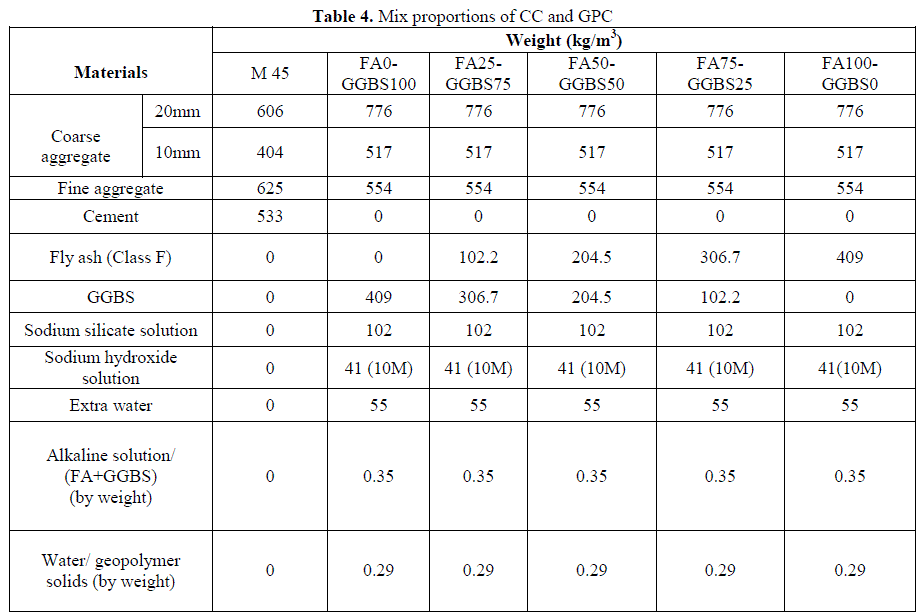 |
| For conventional concrete the compressive strength at 7 days curing period is 26.12Mpa. For geopolymer concrete for mix proportion FA:GGBS:0:100, FA:GGBS:25:75 and FA:GGBS:50:50 the compressive strength value at 7 days curing period are higher than that of the conventional concrete, were as for mix proportion FA:GGBS:75:25 and FA:GGBS:100:0. The compressive strength values are lower than that of the conventional concrete. For conventional concrete the compressive strength at 28 days curing period is 51.39Mpa. For geopolymer concrete for the mix proportion FA: GGBS: 0:100 and FA: GGBS: 25:75, the compressive strength values at 28 days curing period are higher than that of the conventional concrete, were as for mix proportion FA: GGBS: 50:50, FA: GGBS: 75:25 and FA: GGBS: 100:0. The compressive strength values are lower than that of the conventional concrete. Similar trend is observed at 56 and 90 days curing period. |
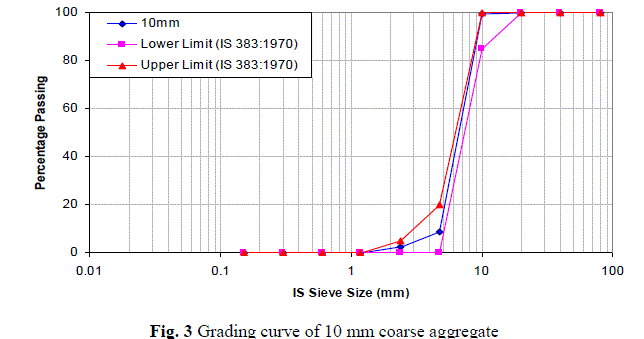 |
| The variation of the compressive strength of geopolymer concrete for the various mix proportions of FA: GGBS and for different curing period is shown as bar diagram in Fig 4. From the bar diagram it is clear that the geopolymer concrete blended with 100% GGBS shown maximum compressive strength value at all curing periods and the values are greater than that of the conventional concrete (M45 grade). In case of geopolymer concrete blended with 100% FA. The compressive strength values are maximum at all curing periods and the values are lower than that of conventional concrete (M45 grade). The variation of compressive strength of geopolymer concrete with various proportions of FA: GGBS is shown in Fig 5. From Fig 5, it is observed that compressive strength of geopolymer concrete decreases with increasing FA content in the mix irrespective of curing period. It is also observed that for a given proportion of the mix, the compressive strength increases with age. The compressive strength of geopolymer concrete is maximum, when the proportion FA: GGBS: 0:100 irrespective of curing period. |
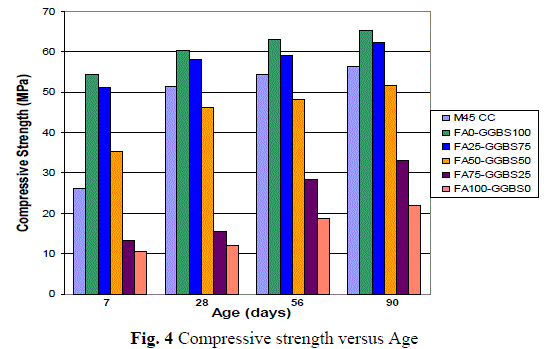 |
| The compressive strength of geopolymer concrete is compared with the compressive strength of conventional concrete at same age. That is, conventional concrete is considered as the reference mix. The percentage increase in compressive strength values of geopolymer concrete at 7, 28, 56 and 90 days are 107.8%, 17.2%, 16.3% and 15.7% respectively. It is seen that rate of gain in compressive strength of geopolymer concrete is very faster at 7 days curing period and the rate gets reduced with age. |
| b. Split tensile strength |
| Table 6 shows the split tensile strength of CC (M 45) and GPC mixes at different curing periods. For conventional concrete the split tensile strength at 7 days curing period is 2.23Mpa. For geopolymer concrete for mix proportion FA:GGBS:0:100 and FA:GGBS:25:75 the split tensile strength values at 7 days curing period are higher than that of the conventional concrete, were as for mix proportion FA:GGBS:50:50, FA:GGBS:75:25 and FA:GGBS:100:0. The split tensile strength values are lower than that of the conventional concrete. For conventional concrete the split tensile strength at 28 days curing period is 3.44Mpa. For geopolymer concrete for the mix proportion FA: GGBS: 0:100, the split tensile strength values at 28 days curing period are higher than that of the conventional concrete, were as for mix proportion FA:GGBS:25:75,FA: GGBS: 50:50, FA: GGBS: 75:25 and FA: GGBS: 100:0. The split tensile strength values are lower than that of the conventional concrete. Similar trend is observed at 56 and 90 days curing period. |
 |
| The variation of the split tensile strength of geopolymer concrete for the various mix proportions of FA: GGBS and for different curing period is shown as bar diagram in fig 6. From the bar diagram it is clear that the geopolymer concrete blended with 100% GGBS shown maximum split tensile strength values at all curing periods and the values are greater than that of the conventional concrete (M45 grade). In case of geopolymer concrete blended with 100% FA. The split tensile strength values are maximum at all curing periods and the values are lower than that of conventional concrete (M45 grade). The variation of split tensile strength of geopolymer concrete with various proportions of FA: GGBS is shown in Fig 6. From Fig 6, it is observed that split tensile strength of geopolymer concrete decreases with increasing FA content in the mix irrespective of curing period. It is also observed that for a given proportion of the mix, the split tensile strength increases with age. The split tensile strength of geopolymer concrete is maximum. When the proportion FA: GGBS: 0:100 irrespective of curing period. The split tensile strength of geopolymer concrete is compared with the split tensile strength of conventional concrete at same age. That is, conventional concrete is considered as the reference mix. The percentage increase in split tensile strength values of geopolymer concrete at 7, 28, 56 and 90 days are 23.76%, 3.48%, 8.83% and 13.09% respectively. It is seen that rate of gain in split tensile strength of geopolymer concrete is very faster at 7 days curing period and the rate gets reduced with age. The variation of split tensile strength of geopolymer concrete with various proportions of FA:GGBS is shown in Fig.7. From the Fig.7, it is observed that split tensile strength of geopolymer concrete decreases with increasing FA content in the mix irrespective of curing period. It is also observed for a given proportion of the mix, the split tensile strength increases with age. |
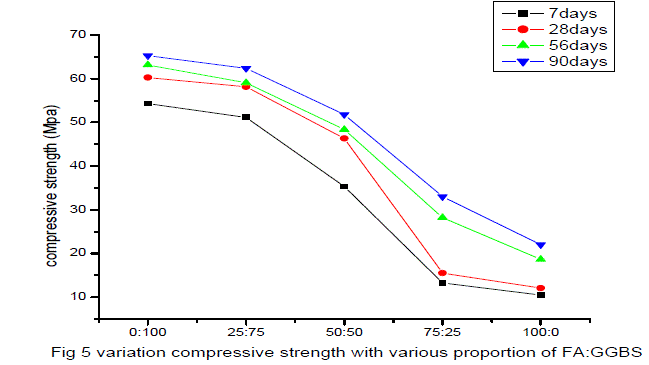 |
CONCLUSIONS |
| Based on the results reported in this investigation, the following conclusions are drawn |
| 1. The compressive strength and split tensile strength of geopolymer concrete decrease with increasing FA content in the mix irrespective of curing periods. |
| 2. For a given proportion of a mix, the compressive strength and split tensile strength increase with age. |
| 3. The compressive strength and split tensile strength of geopolymer concrete is maximum for the FA0-GGBS100 irrespective of curing period. |
| 4. The rate of gain in compressive strength and split tensile strength of geopolymer concrete is very fast at 7 days curing period and the rate gets reduces with age. |
| 5. Geopolymer concrete can be recommended as an innovative construction material for the use of the use of construction |
References |
|